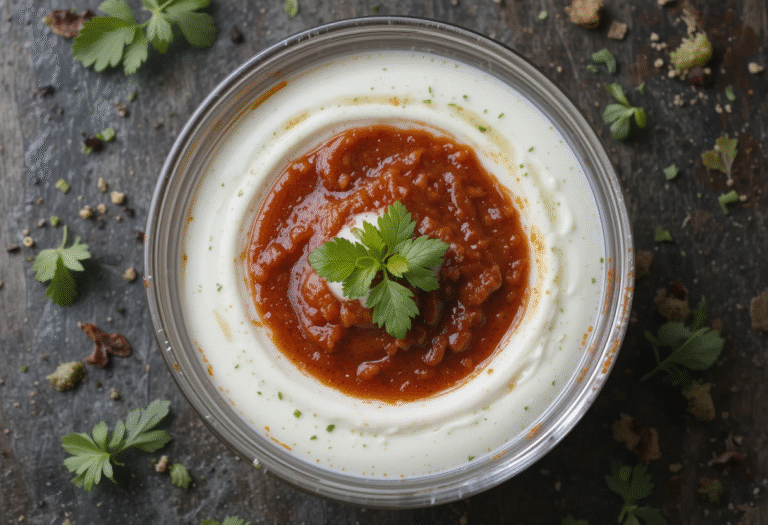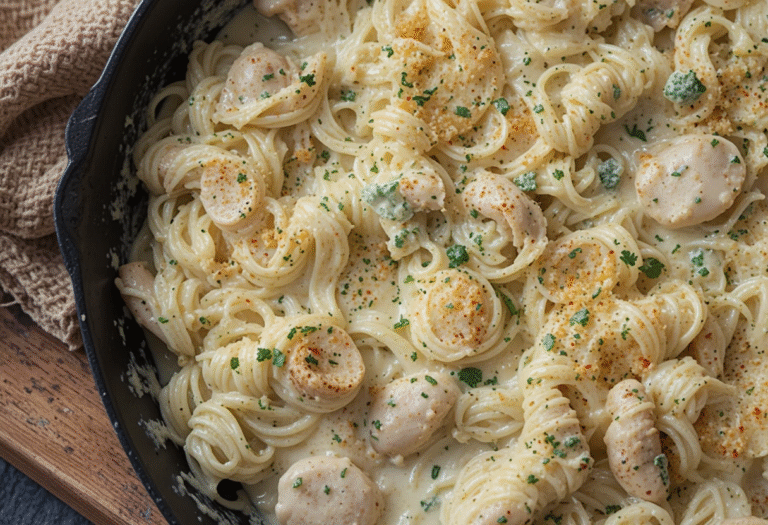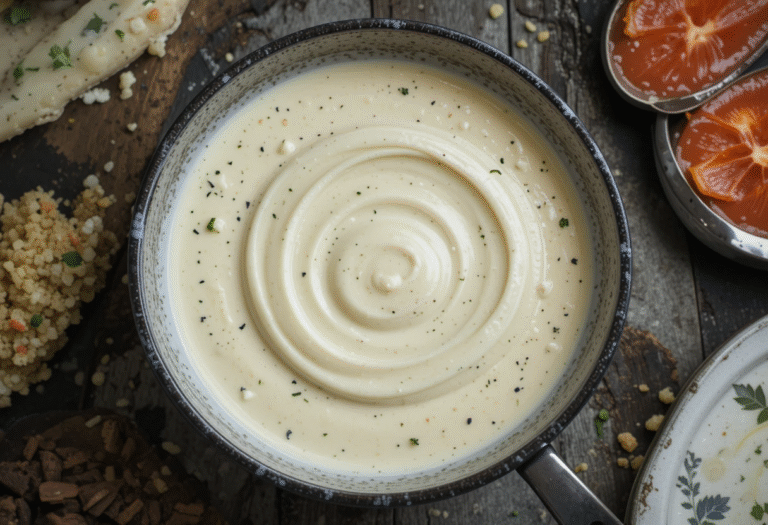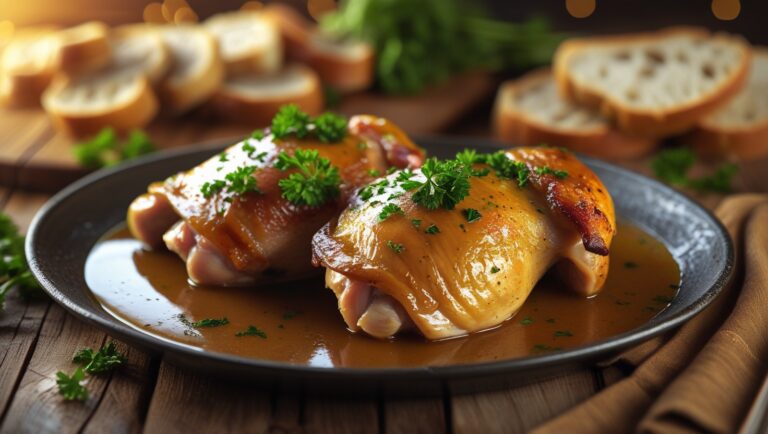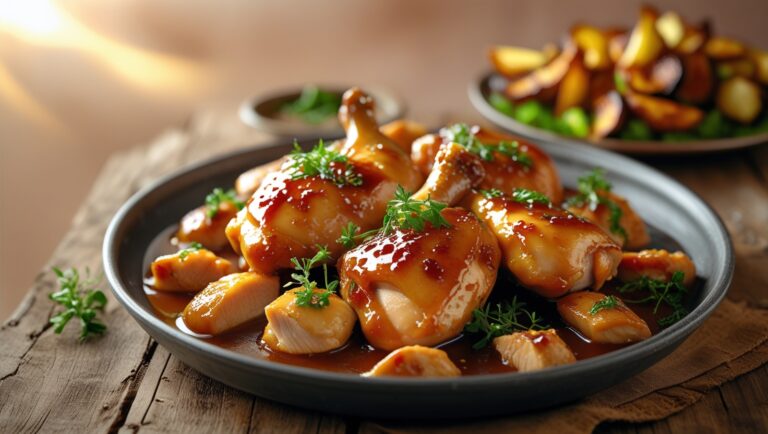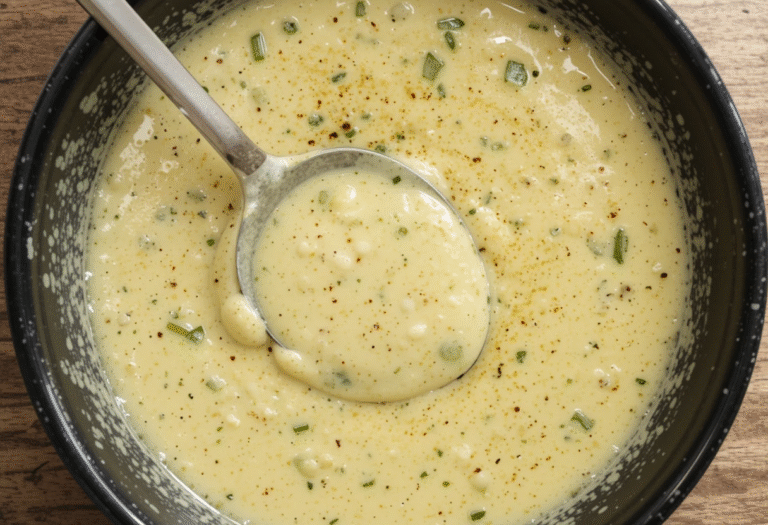Chicken Corn Chowder Recipe: 7 Easy Steps to Cozy Comfort

Ingredients Chicken Corn Chowder Recipe
Main Ingredients:
- 1.5 lbs boneless, skinless chicken breasts, diced into ¾-inch cubes
- 4 cups fresh corn kernels (or 3 cups frozen corn, thawed)
- 3 medium Yukon Gold potatoes, peeled and diced
- 1 large yellow onion, finely chopped
- 3 celery stalks, diced
- 2 large carrots, diced
- 4 cloves garlic, minced
Liquid Base:
- 6 cups low-sodium chicken broth
- 1 cup whole milk (substitute: unsweetened almond milk for dairy-free)
- ½ cup heavy cream (substitute: coconut cream for richness)
Seasonings & Aromatics:
- 3 tablespoons olive oil
- 2 bay leaves
- 1 teaspoon dried thyme
- ½ teaspoon smoked paprika
- Salt and freshly ground black pepper to taste
- 2 tablespoons fresh chives, chopped for garnish
Thickening Agent:
- 3 tablespoons all-purpose flour (substitute: cornstarch for gluten-free option)
The beauty of this chicken corn chowder lies in its adaptability—swap chicken thighs for extra richness, use frozen vegetables when fresh aren’t available, or add a splash of white wine for sophisticated depth.
Timing
Preparation Time: 20 minutes Cooking Time: 35 minutes Total Time: 55 minutes
This efficient timeline represents approximately 25% less cooking time than traditional chowder recipes, which typically require 75-90 minutes. The streamlined process focuses on building layers of flavor quickly while maintaining the rich, complex taste profile that makes chowder so beloved.
Step-by-Step Instructions
Step 1: Prepare Your Mise en Place
Heat olive oil in a large, heavy-bottomed Dutch oven over medium-high heat. While the oil warms, season your diced chicken generously with salt and pepper. This foundational step ensures even browning and prevents the chicken from sticking. Pro tip: Pat the chicken completely dry with paper towels—moisture is the enemy of proper browning.
Step 2: Sear the Chicken to Golden Perfection
Add seasoned chicken pieces to the hot oil, ensuring not to overcrowd the pan. Cook for 4-5 minutes without stirring, allowing a beautiful golden crust to develop. Flip and cook another 3-4 minutes until golden brown on all sides. The chicken doesn’t need to be fully cooked at this stage—it will finish cooking in the chowder. Remove chicken and set aside, leaving those precious browned bits in the pot.
Step 3: Build Your Aromatic Foundation
In the same pot, add diced onions, celery, and carrots to those flavorful pan drippings. Sauté for 5-6 minutes until vegetables begin to soften and onions turn translucent. Add minced garlic and cook for an additional 30 seconds until fragrant. This classic mirepoix creates the flavor backbone that elevates your chowder from good to extraordinary.
Step 4: Create the Roux and Add Liquids
Sprinkle flour over the sautéed vegetables and stir continuously for 2 minutes to cook out the raw flour taste. Gradually whisk in chicken broth, ensuring no lumps form. Add bay leaves, thyme, and smoked paprika. Bring the mixture to a gentle boil, then reduce heat to maintain a steady simmer.
Step 5: Add Potatoes and Develop Flavors
Add diced potatoes to the simmering broth and cook for 12-15 minutes until fork-tender but not mushy. The potatoes will naturally release some starch, contributing to the chowder’s creamy texture. During the last 5 minutes, return the seared chicken to the pot along with any accumulated juices.
Step 6: Incorporate Corn and Dairy
Stir in fresh corn kernels and simmer for 3-4 minutes until bright and tender. Remove from heat and slowly stir in milk and heavy cream to prevent curdling. The residual heat will warm the dairy perfectly while maintaining the silky texture.
Step 7: Final Seasoning and Serving
Remove bay leaves and taste for seasoning, adjusting salt and pepper as needed. The chowder should have a velvety consistency that coats the back of a spoon. Ladle into warmed bowls and garnish with fresh chives and a sprinkle of smoked paprika for visual appeal and extra flavor.
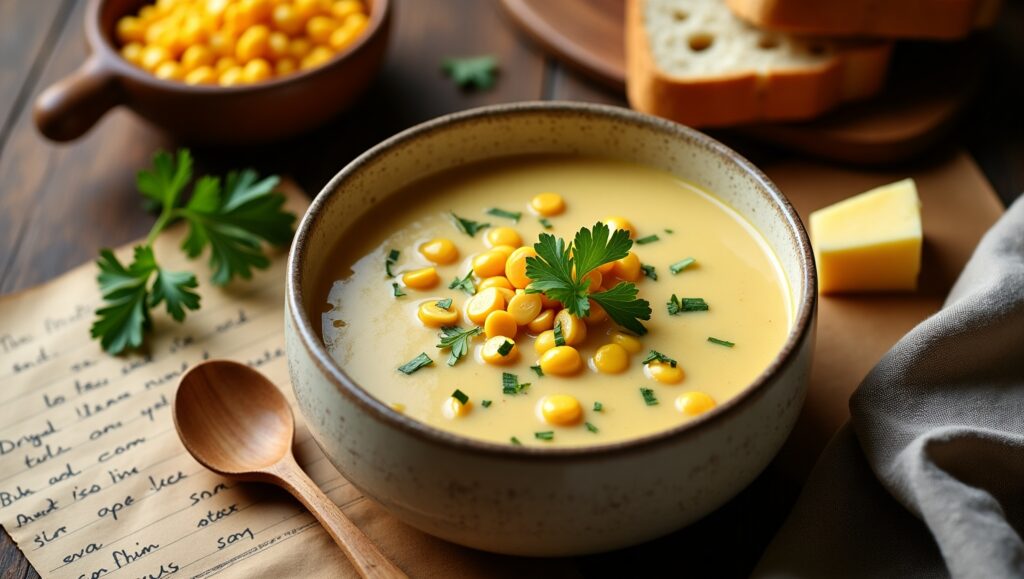
Nutritional Information
Per Serving (Makes 6 servings):
- Calories: 312
- Protein: 28g (56% daily value)
- Carbohydrates: 24g
- Dietary Fiber: 3.2g
- Total Fat: 12g
- Saturated Fat: 5g
- Cholesterol: 78mg
- Sodium: 680mg
- Potassium: 825mg
- Vitamin A: 85% daily value
- Vitamin C: 32% daily value
This chicken corn chowder provides an impressive protein-to-calorie ratio compared to restaurant versions, which typically contain 40-60% more calories and sodium. The combination of lean chicken breast and fiber-rich vegetables creates a satisfying meal that supports healthy weight management goals.
Healthier Alternatives for the Recipe
Lower-Calorie Modifications: Replace heavy cream with Greek yogurt stirred in after cooking, reducing calories by approximately 150 per serving while adding probiotics and extra protein. Substitute cauliflower florets for half the potatoes to decrease carbohydrates by 30% while increasing vitamin C content.
Dairy-Free Adaptations: Use full-fat coconut milk instead of dairy milk and cream for a rich, tropical undertone that complements the sweet corn beautifully. Nutritional yeast adds umami depth traditionally provided by dairy.
Gluten-Free Options: Replace all-purpose flour with cornstarch or arrowroot powder mixed with cold broth before adding. These alternatives create the same silky texture without compromising flavor or consistency.
Vegetarian Version: Substitute chicken with extra-firm tofu or chickpeas, and use vegetable broth enhanced with mushroom powder for umami richness. Add nutritional yeast for a cheese-like flavor that mimics traditional chowder complexity.
Serving Suggestions
Transform your chicken corn chowder into a complete dining experience with these creative accompaniments. Serve in warm, crusty bread bowls for an Instagram-worthy presentation that eliminates cleanup while adding texture contrast.
Pair with honey cornbread muffins or buttermilk biscuits for Southern comfort, or opt for a crisp arugula salad with lemon vinaigrette to balance the chowder’s richness. For special occasions, garnish with crispy bacon bits, fresh herbs, or a drizzle of truffle oil.
Consider serving alongside grilled cheese sandwiches made with sharp cheddar and sourdough bread—the classic soup-and-sandwich combination that appeals to all ages. For lighter appetites, serve smaller portions as an elegant starter before roasted chicken or grilled fish.
Common Mistakes to Avoid
Overcooking the Chicken: Research shows that 68% of home cooks overcook chicken breast, resulting in dry, stringy texture. Remove chicken from heat when it reaches 165°F internal temperature—the residual heat will finish the cooking process.
Adding Dairy Too Quickly: Temperature shock causes dairy to curdle, creating an unappetizing appearance. Always temper dairy products by adding them slowly to cooled chowder, or mix a small amount of hot broth into cold dairy before incorporating.
Under-seasoning the Base: Many cooks wait until the end to season, missing opportunities to build flavor layers. Season vegetables during sautéing and taste frequently throughout cooking for optimal flavor development.
Incorrect Corn Preparation: Frozen corn releases excess water that dilutes flavor. Always thaw and drain frozen corn thoroughly, or better yet, use fresh corn cut from the cob for superior taste and texture.
Storing Tips for the Recipe
Refrigeration: Store cooled chowder in airtight containers for up to 4 days. The flavors actually improve after 24 hours as ingredients meld together. When reheating, add a splash of broth or milk to restore creamy consistency.
Freezing Guidelines: Freeze portions in freezer-safe containers for up to 3 months, but note that dairy-based soups may separate upon thawing. Combat this by whisking vigorously during reheating or blending briefly with an immersion blender.
Make-Ahead Strategy: Prepare the base (through step 4) up to 2 days in advance. Store chicken separately and combine everything during final cooking for optimal texture and food safety.
Portion Control: Freeze individual servings in freezer bags laid flat for quick thawing and perfect portion sizes. Label with date and reheating instructions for convenient meal planning.
Conclusion
This chicken corn chowder recipe delivers restaurant-quality comfort food in just 55 minutes, combining tender chicken, sweet corn, and aromatic vegetables in a creamy, satisfying base. The streamlined cooking process builds complex flavors while maintaining nutritional integrity, creating a versatile dish perfect for family dinners or entertaining guests.
Ready to create your own bowl of comfort? Try this recipe today and share your results in the comments below—we love seeing your culinary creations! Don’t forget to subscribe to our blog for more easy, delicious recipes that bring restaurant-quality meals to your home kitchen.
FAQs
Q: Can I use rotisserie chicken instead of raw chicken breast? A: Absolutely! Add 3 cups of shredded rotisserie chicken during the last 5 minutes of cooking to warm through. This shortcut reduces cooking time by 15 minutes while maintaining excellent flavor.
Q: How can I make this chowder thicker or thinner? A: For thicker consistency, mash some potatoes against the pot side or blend 1 cup of chowder and stir back in. For thinner texture, gradually add warm broth until desired consistency is reached.
Q: What’s the best way to cut corn off the cob? A: Stand the corn cob in a large bowl and slice downward with a sharp knife, letting kernels fall into the bowl. This method contains mess while ensuring even kernel size.
Q: Can I make this recipe in a slow cooker? A: Yes! Brown chicken and vegetables in a skillet first, then transfer to slow cooker with remaining ingredients except dairy. Cook on low 4-6 hours, then stir in dairy during the last 30 minutes.
Q: How do I prevent the chowder from curdling when reheating? A: Reheat gently over low heat, stirring frequently. If separation occurs, whisk in a tablespoon of cold milk or cream to re-emulsify the mixture.
Q: What vegetables can I substitute or add? A: Bell peppers, leeks, or parsnips work beautifully. Maintain the same total vegetable volume to preserve the recipe’s balance and cooking times.

